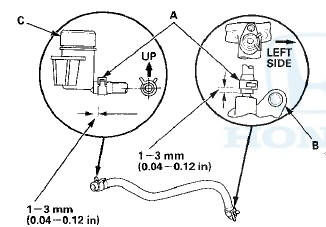 Honda Accord: Clutch Master Cylinder Replacement
Honda Accord: Clutch Master Cylinder Replacement
NOTE: - Use fender covers to avoid damaging painted surfaces.
- Do not spill brake fluid on the vehicle; it may damage the paint or plastic. If brake fluid does contact the paint or plastic, wash it off immediately with water.
1. Remove and discard the brake fluid from the clutch master cylinder reservoir with a syringe or other suitable device.
2. Pry out the lock pin (A), and pull the clevis pin (B) out of the clevis. Remove the master cylinder mounting nuts (C).

3. Remove the reservoir mounting bolt (A) and the retaining clip (B), then disconnect the clutch line (C) from the clutch master cylinder (D), and remove the O-ring (E). Plug or wrap the end of the clutch line with a clean shop towel to prevent brake fluid from coming out.

4. Remove the master cylinder (A) and the clutch master cylinder seal (B).

5. Install a new master cylinder seal (A), then install the master cylinder (B).

6. Install a new O-ring (A) on the clutch line (B), then install the clutch line in the clutch master cylinder (C) with a new retaining clip (D). Install the master cylinder reservoir mounting bolt (E).
NOTE: - Apply silicone grease (P/N 08C30- B0234M) to the O-ring and the end of the clutch line.
- Make sure not to get any silicone grease on the terminal part of the connectors and switches, especially if you have silicone grease on your hands or gloves.

7. To prevent the retaining clip (A) from coming off, pry apart the tip of the ciip (B) with a screwdriver.

8. Make sure the hose clamps (A) are positioned on the master cylinder (B) and reservoir (C) as shown.

9. Install the master cylinder mounting nuts (A).

10. Apply multipurpose grease to the clevis pin (B) and the mating surfaces (C) of the clevis and the pedal.
Slide the clevis pin into the clevis, then install the lock pin (D).
11. Bleed the clutch hydraulic system (see page 12-6).
12. Adjust the clutch pedal, the clutch pedal position switch, and the clutch interlock switch (see page 12-7).
13. Check the clutch operation, and check for leaks.
14. Test-drive the vehicle.
 Clutch Pedal Assembly Replacement
Clutch Pedal Assembly Replacement
1. Disconnect the clutch pedal position switch connector
(A) and the clutch interlock switch connector (B).
2. Pry out the lock pin (C), and pull the clevis pin (D) out
of the clevis.
3. Remov ...
 Slave Cylinder Replacement
Slave Cylinder Replacement
NOTE:
- Use fender covers to avoid damaging painted
surfaces.
- Do not spilt brake fluid on the vehicle; it may damage
the paint or plastic. If brake fluid does contact the paint
or plastic, wa ...
See also:
Mirror Housing Cover Replacement
1. Remove the mirror holder (see page 20-63).
2. From the mirror holder opening, release the hooks (A)
of the mirror housing cover (B).
3. Release the hooks (A), then remove the mirror
housing ...
Dust and Pollen Filter
This filter removes the dust and
pollen that is brought in fromthe
outside through the heating and
cooling system/climate control
system.
Have your dealer replace this filter
when this serv ...
Clutch Hydraulic System Bleeding
NOTE:
- Do not reuse the drained fluid. Always use Honda
DOT 3 Brake Fluid from an unopened container. Using
a non-Honda brake fluid can cause corrosion and
shorten the life of the system.
- Ma ...
